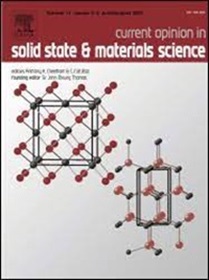Computational materials assessment of the D/Li-stripping neutron source as a prototypical facility for fusion materials testing
IF 13.4
2区 材料科学
Q1 MATERIALS SCIENCE, MULTIDISCIPLINARY
Current Opinion in Solid State & Materials Science
Pub Date : 2025-07-19
DOI:10.1016/j.cossms.2025.101231
引用次数: 0
Abstract
As the US fusion materials community awaits the selection and design of a fusion prototypical neutron source (FPNS), a risk reduction exercise has been conducted to (i) provide an updated materials performance evaluation using state-of-the-art computational materials modeling, (ii) expand on legacy analysis based on pure Fe to other relevant fusion structural materials types, and (iii) ensure that materials response under FPNS operational conditions is consistent with referential fusion reactor conditions. The current paper describes the efforts undertaken to assemble a comprehensive computational methodology that includes neutronics, primary damage calculations, atomistic simulations of displacement cascades, chemical inventory evolution calculations, and a computational thermodynamic analysis of emerging phases during irradiation. Our work extends existing studies in pure Fe to reduced-activation ferritic/martensitic steels, tungsten, silicon carbide, and vanadium alloys. We focus on the single-beam deuteron/lithium-stripping neutron source behind the IFMIF-DONES concept, which we assess against ITER, two DEMO designs, and an ideal pure 14-MeV flux. Our analysis indicates that, within standard uncertainties inherent to the models employed, the DONES concept adequately captures fusion conditions in the four materials analyzed. Our work is intended as a comprehensive irradiation damage analysis of fusion-representative neutron sources, to be used for further neutron source evaluation and fusion facility operation.
D/ li溶出中子源作为聚变材料测试的原型设备的计算材料评估
在美国核聚变材料界等待核聚变原型中子源(FPNS)的选择和设计之际,已经开展了一项降低风险的工作,以(i)使用最先进的计算材料建模提供最新的材料性能评估,(ii)将基于纯铁的遗留分析扩展到其他相关的核聚变结构材料类型。(iii)确保FPNS运行条件下的材料响应与参考聚变反应堆条件一致。当前的论文描述了为组装一个综合计算方法所做的努力,该方法包括中子学、初级损伤计算、位移级联的原子模拟、化学库存演化计算和辐照期间新兴阶段的计算热力学分析。我们的工作将纯铁的现有研究扩展到低活化铁素体/马氏体钢、钨、碳化硅和钒合金。我们专注于IFMIF-DONES概念背后的单束氘核/锂剥离中子源,我们对ITER,两个DEMO设计和理想的纯14mev通量进行了评估。我们的分析表明,在所采用的模型固有的标准不确定性范围内,DONES概念充分捕捉了所分析的四种材料的聚变条件。我们的工作旨在对具有代表性的中子源进行全面的辐照损伤分析,用于进一步的中子源评估和聚变设施的运行。
本文章由计算机程序翻译,如有差异,请以英文原文为准。
求助全文
约1分钟内获得全文
求助全文
来源期刊

Current Opinion in Solid State & Materials Science
工程技术-材料科学:综合
CiteScore
21.10
自引率
3.60%
发文量
41
审稿时长
47 days
期刊介绍:
Title: Current Opinion in Solid State & Materials Science
Journal Overview:
Aims to provide a snapshot of the latest research and advances in materials science
Publishes six issues per year, each containing reviews covering exciting and developing areas of materials science
Each issue comprises 2-3 sections of reviews commissioned by international researchers who are experts in their fields
Provides materials scientists with the opportunity to stay informed about current developments in their own and related areas of research
Promotes cross-fertilization of ideas across an increasingly interdisciplinary field
 求助内容:
求助内容: 应助结果提醒方式:
应助结果提醒方式:


